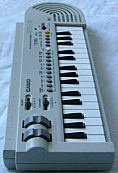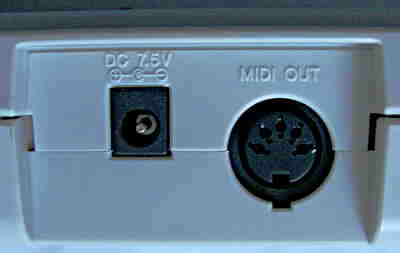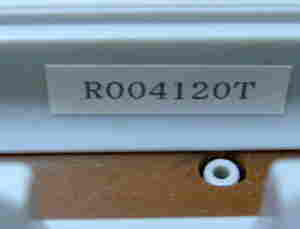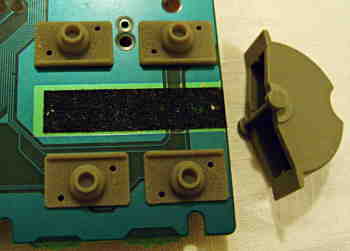 |
 |
This concrete coloured Casio cucumber of 1995 (embossed case date) was likely the world smallest MIDI keyboard with integrated sound and speaker. But it has only 10 preset sounds, no rhythm, and despite Casio gladly called it a "midi master keyboard", even the MIDI playability is very restricted since it not only lacks velocity but even the pitch and modulation wheels are fake and only behave like buttons instead of sending intermediate analogue values.
 |
 |
(Note: This keyboard is not worth to buy for its internal sound unless you want the pitchbend, vibrato and 4 note polyphonic mini keys; other SA-series keyboards sound is more versatile. The GZ-5 was mainly interesting for laptop musicians or mini keys freaks those wanted to use MIDI, but even for this it is nothing great, thus do not pay too much. Nowadays many more useful small USB controller alternatives exist.)
 |
 |
 |
demo "Wake Me Up Before You Go-Go" (by Wham!) 9-step pitchbend wheel
The pitchbend and modulation wheel of this instrument are a similarly
bad hoax like the scratch disc of Casio
Rapman RAP-1, because they contain no analogue potentiometers but
only mechanically simulate button presses on silicone contacts (on and
off).  At
least their value range can be adjusted by entering numbers (press "bend
sense" + number + "enter"). Casio really should have added real
analogue controls here, since these fake wheels disqualify this self-claimed
"MIDI master keyboard" far more for serious use than the lack of velocity
sensing keys. Bizarre is that the keyboard matrix was indeed prepared for
a contact row with some intermediate steps. The PCB is based on classic
SA-series
single-chip hardware. At
least their value range can be adjusted by entering numbers (press "bend
sense" + number + "enter"). Casio really should have added real
analogue controls here, since these fake wheels disqualify this self-claimed
"MIDI master keyboard" far more for serious use than the lack of velocity
sensing keys. Bizarre is that the keyboard matrix was indeed prepared for
a contact row with some intermediate steps. The PCB is based on classic
SA-series
single-chip hardware. |
In "internal" (sound) mode only the pitchbend range can be adjusted among 4 depths; press "bend sense", type a cipher between 0 and 3 for the number of semitones per direction and press "enter" (i.e. 0=off). The pitchbend always glides quite fast when the wheel is moved. The modulation wheel adds a 6Hz vibrato so long it is pressed. The 10 OBS preset sounds are simply a subset of Casio SA-1; "e. piano" corresponds to its "elec piano", "organ" to "jazz organ", "e. guitar" to "elec guitar", "e. bass" to "elec bass", "brass" to the famous tooting "brass ens.", "flute" to "quena", "synth-lead" to "synth-reed". (If you like the vibrato sound style of this thing, also watch out for the fullsize MIDI keyboard Kawai PH50, which has plenty more of such sounds with genuine continuous pitchbend and modulation control through a joystick.)
Like midsize SA-series keyboards (see Casio
SA-21), the main voice is 4 note polyphonic and hisses less than
those 2 note polyphonic mini keyboards, and like there the volume control
and preset sound selection does not change held notes, which can be used
for live play tricks; here even the buttons don't play disturbing click
noises. But the very limited count of preset sounds and the total lack
of rhythm makes the internal sound source quite useless. This was obviously
an annoying marketing decission because the demo song easteregg reveals
that the SA-series100 ToneBank sound engine is still intact and
wasn't removed to make the MIDI functions fit. Even when it were more expensive;
a fully functional SA-1 with MIDI- out, MIDI- in, working octave switch
and real analogue pitch and mod wheels would have been much more fun than
this crippled thing. For a highly compact laptop MIDI keyboard the large
speaker section and bulky case of the GZ-5 only wastes space, thus the
GZ-5 is not really good for anything. The SA-1 case was smaller and slimmer.
hardware detailsThe Casio GZ-5 is based on the SA-series CPU "OKI M6387-A23". The midi-out port is read on CPU pin 19.
keyboard matrixThe GZ-5 matrix has diodes because unlike other Casio mini keyboards it is 4-note polyphonic. Despite same CPU the layout strongly differs from SA-series, which hints that the software was made from scratch to fit the midi routines. The fake pitch and modulation wheels only simulate button presses and hence have no analogue inputs.This matrix is based on the Casio GZ-5 service manual. I haven't analyzed
it by myself, so there may be still unknown eastereggs.
The input lines are active-high, i.e. react on +Vs. Any functions can
be triggered by a non- locking switch in series to a diode from one "out"
to one "in" pin.
eastereggs: A button wired to KO4->KI0 plays the demo song of Casio SA-1, which is a nice rendition of "Wake Me Up Before You Go-Go". The fact that it can play this indicates that almost the whole sound engine of the CPU was left intact. I had expected that Casio removed most of it to free rom space to make the midi mode and many note frequency lookup tables for implementing pitchbend fit. So apparently it was an annoying marketing decission to cripple the user interface to only 10 preset sounds and no rhythms. There is still a stop button at KO4->KI2 that here only stops the demo. Bizarre is that connecting a switch KO6->KI2 halts the demo while closed (notes are held, envelopes keep decaying normal). Connecting KO6->KI1 distorts and garbles the demo in strange ways. Apparently this messes up the track syncing of the internal sequencer, so it e.g. plays wrong rhythm, but when it doesn't crash entirely, the music continues normal after a while when it starts the next internal pattern of the song, which hints to its internal structure. To my surprise, the pitchbend matrix row supports 8 steps (4 in each direction). Apparently Casio had originally planned a kind of 9 position rotary switch (center position open) and cancelled it to cut cost. Also the row of the modulation wheel looks like designed for supporting more, but in "internal" (play) mode I found none. I did not search in midi mode, so there may still unknown midi eastereggs. Once I triggered a glitch mode where the modulation wheel sounded a fast repeating bassy click, so there may be a hidden feature to assign it to different tagets than vibrato. The same click also sounds when closing more than 1 contact in the velocity or octave switch, so it is likely an error signal. |
Another keyboard in grey ugly concrete building design was Antonelli
2381.
| removal of these screws voids warranty... | ||
 |
||
|
|